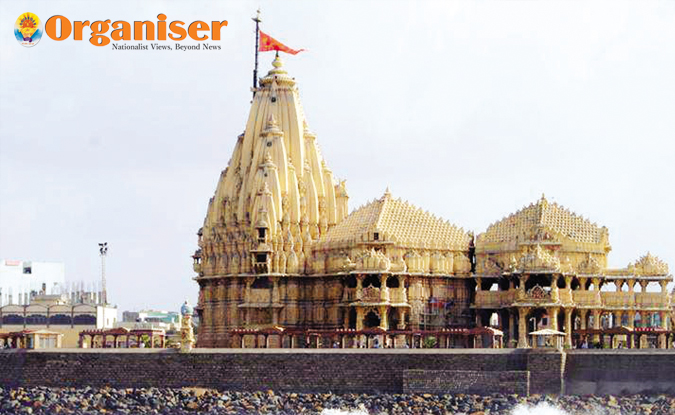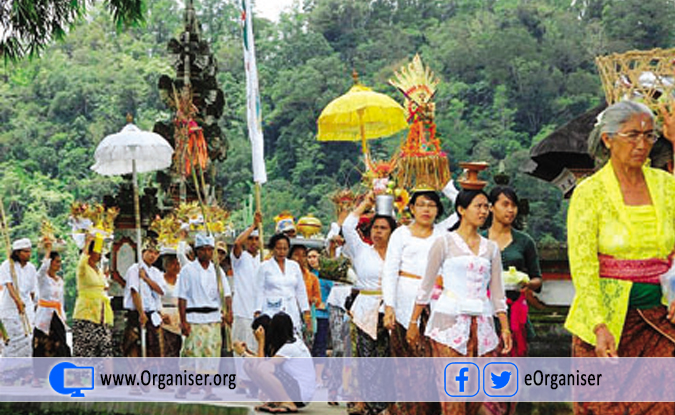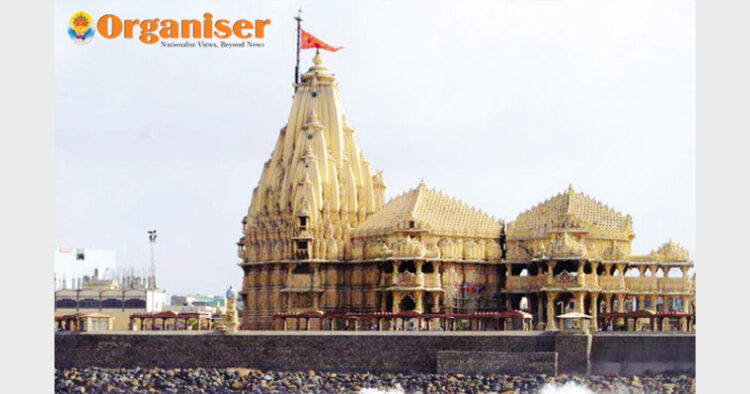Hindus were never inward looking people. They were cosmopolitan in approach and roamed around the world, learning from and teaching others’ culture
The shloka inscribed on the pillar at Somnath reads—“Aasamudrant Dakshindhruvparyant Abadhit Jyotirmarga.” (There is no obstruction (land) in straight-line from this point to South Pole. The path of flame (light) can reach straight up to it from here.)

Somnath Temple on the sea coast in Gujarat remained a destination for people arriving from around the world
Obviously, if we, Bharatiyajan knew the South Pole 1500 or 2000 years ago, they must have passed round the Earth. That is, there must certainly be footprints of Indians on the surface of the earth. Bharat enjoyed top position in global trade with 27 per cent to 30 per cent share till a thousand years ago from today. Now any person leaving for the trade creates his colony, howsoever small it may be, in every region. Just as in Bharat, Marwadi community of Rajasthan has created its pockets at many places from Bangladesh to Assam to even Dakshin Bharat.
However, not much documentation is found about the global footprints of ancient Bharatiyas. Dr Sharad Hebalkar from Ambejogai has written a beautiful book—’Bharatiya Sanskruticha Vishwa Sanchar’. Many an excavation have taken place after this book, that was written in 1980s, and a lot of new information has been obtained. Therefore, thorough research is needed on this subject. Dr Raghuveer has written a lot about the presence of Bharatiya people in the world. Particularly the influence of Hindu culture in Mongolia was close to his heart. ‘Hindu America’ by Dr Chamanlal is also a famous book.

A procession with offerings entering a Hindu temple in Bali
All these books describe the worldwide journey of Hindu or Bharatiya culture. But history researches need evidences but not much work to collect those evidences has taken place during last 20/25 years.
Dr Vishnu Sridhar (Haribhau) Wakankar is a renowned archeologist. ‘Bhim betka’ caves, carrying the signs of primitive life in Madhya Pradesh, are his find. While writing the preface to Dr Sharad Habalkar’s book, Haribhau has given his experiences during the journey in the United States and Mexico in 1984.
In it, he has mentioned Barryfel, the head of Archeology Museum of San Diego, USA. This Mr Barryfel has refered to the text written in the language and script of great Indian seafarer ‘Vasulun’ that was found at Tavsuko, in the north-western province Yakutan of Mexico in a Mayan temple. And from this proof, Barryfel has stated unequivocally that Indians were going there in the eighth/ninth century. Unfortunately, no image of this ‘Vasulun’ is available anywhere. Thus, the inscription will certainly be there in the museum. But no one has tried to get there and publish his image. Strong evidence is needed to make any statement. A great work is needed to collect it. However, we are getting such evidences now. Indian/Hindu/Vedic —name it in any way, the existence of our ancient civilization is being found all over the world.
The instances of our culture can still be seen today to the eastern side of Bharat. But the existence of the Vedic culture 2000 to 3000 years ago to the west, especially in Egypt and Europe, stands out. An Out of India Theory (OIT) was propounded some time ago. According to this theory, some civilised cultures/tribes/groups from India migrated to Europe and Africa for various reasons.
Origins of Celtics
An archeologist, Druuis Belenois Ategnatos, has stated that Celtics are part of the Hindu/Vedic tribes. According to his theory, the origin of the Celtic people was in the state of ‘Uttar (North) Kuru’. North Kuru is the north-western part of the Himalayas. According to many historians, Vedic culture existed earlier even to the north of Himalayas. Vedic culture thrived especially in vast areas from Kyrgyzstan to the left to Tibet to the right. Later, some members of the tribe converted to Buddhism because of the influence of Buddhism. They stayed on while those who continued to follow Sanatan Vedic Dharma moved towards Europe. Those are the Celtics…!
Many of their occasional customs and practices are closer to Vedic lot even today. Many European historians have given the Celtic people name of “Brahmins of Europe”, because they follow many of the customs of Vedic religion to this date. History expert Peter Berresford Ellis has also said that Celtic group is one of the groups of Hindus following the ancient Vedic culture that later migrated to Europe with time.
Writings of history researcher Shreekant Talgeri are available in great deal on this topic. Talgeri’s theory says that many Hindu groups had started migrating towards Afghanistan and Europe since pre-Rugveda period. That is why great and small signs of Hindu civilisation are found at the base of many European cultures. Talgeri opines that the period of writing of Rugveda was stretched over 200 to 300 years.
There is another such group living in Iraq, Syria, Germany, Armenia and Russia. This ‘Yazidi’ group is neither Muslim, nor Christian. It does not follow Zorashtrian faith either. They have their own ‘Yazidi sect’. This sect, though, is very close to Hinduism. Many researchers have called this ‘Yazidi’ sect one of the lost sects of Hindus in West Asia. There are different opinions on their exact number. Many opine that number of this sect is 15 lakh. People following this sect are mainly living in Iraq and Syria.
Interestingly, a portal called ‘Pakistan Defence’ (www.defence.pk) has published a detailed article titled ‘The Yazidi Culture is very similar to a Hindu sect’. As per information given in the article, there are only 7 lakh remaining Yazidis in the world and they are mostly living in areas nearby Kurdistan in Iraq. This article tried to prove, with many proofs, that Yazidi is a migrated group of ancient Hindus.
The places of worship of Yazidis look exactly like Hindu temples. Their temples are adorned with the picture of Naga (snake) on them. Most importantly, the most sacred mark of the people of Yazidi consists of peacock with blooming feathers. Interestingly, peacock is found nowhere in Iraq, Syria or anywhere else. And this peacock is similar to the traditional picture/image of Tamil lord Subramaniam. Yellow sun is the symbol of Yazidis. This sun has 21 rays and number is 21 considered auspicious in Hinduism. Lamps like ours, lighting of lamp similar to ours, the bindi of purity on the forehead of women, the same belief in rebirth… many Hindu customs and rituals stand out here.














Comments